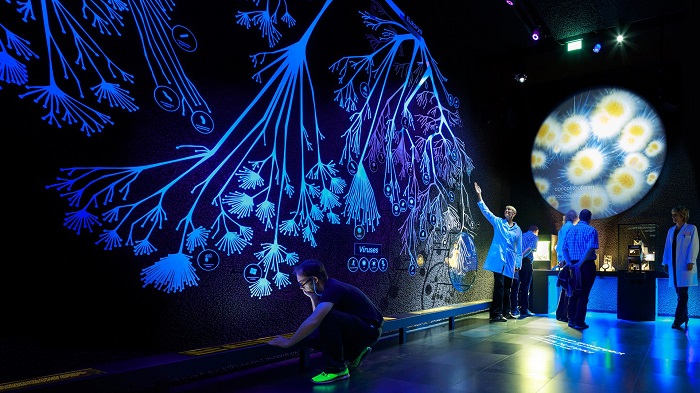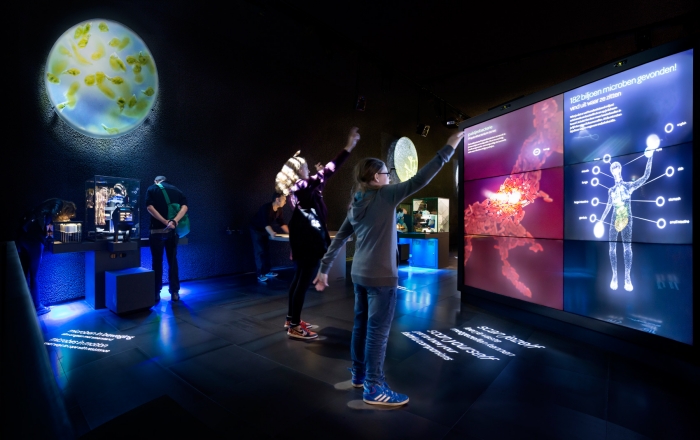These are the most famous Amsterdam tourist attractions & sight tours which sees thousands and millions of visitors each year:
Visitors to Amsterdam want to see all the big sights. The Micropia, the Royal Palace and Dam Square, these stunning sights draw tourists in and get their camera shutters clicking.
We\'re talking, of course, about Micropia - the world's only museum of microbes.
Micropia is located on the grounds of Natura Artis Magistra, Amsterdam's royal zoo. Within the Zoo's enclosures, cages, and tanks, the usual menagerie goes about their business. Lions roar, giraffes munch leaves, and birds squawk. Across the way in Micropia, trillions of bacteria and other microorganisms flinch, wriggle and multiply, invisibly shaping our world, and ourselves.

The below table includes a brief description of various handpicked Micropia tickets & skip the line guided tours of the Micropia. They're based on users reviews, cost, customer experience as well as all the best ways to see the famous Micropia sight.
We've compared prices from a variety of skip the line Micropia guided tours & tickets, websites and have handpicked the most affordable Micropia combination tickets, but utterly enjoyable Micropia tours & tickets below:

What Is It
What Will Do
What Inclues
Travellers Talk
Is It Right
There are a number of places you can buy your Micropia tickets.
Micropia In-PersonYou can buy tickets for Micropia in-person at the Micropia ticket desk.
These are the prices for both single tickets and package tickets. Micropia and ARTIS tickets include entry into the Zoo.
|
Micropia
|
|
Micropia & ARTIS Combination Tickets
|
Before a draper named Antoni van Leeuwenhoek first peered through a home-made microscope, nobody knew a thing about microorganisms. No one had even thought to look. With no scientific training, Antoni experimented with animal and plant matter. But it wasn't until he looked at water and saw movement that he realized there is invisible life all around us. Antoni called what he saw animalcules. Today we know them as bacteria.

ARTIS was established in 1838. Since it's inception this institution has worked to improve the public's understanding of the natural world. Micropia is the next step in that mission. We all know that microorganisms are to blame for some nasty diseases but microbiology is a positive force. One that, Micropia shows, can offer solutions to many of the world's problems including climate change and food shortages. More than a museum, Micropia is a platform that links ordinary science with the spectacular world of microbiology. No lab coats here, the learning at Micropia is hands on. Visitors to Micropia get to see themselves, see inside themselves, in a way they never have before.
Micropia covers two floors of "Lendenlokalen", the Zoo's historical building on the Artisplein in Amsterdam's Plantage neighborhood.
There are more than 30 exhibits in Micropia. Around half of these exhibits contain live organisms from the Micropia collection. Not quite a museum and not quite a zoo, Micropia takes an innovative approach to breach the gap between scientific research, industry and the public.
Micropia's in-house laboratory is an attraction in itself. Here, laboratory staff work each day to maintain the live exhibits, keeping their microorganisms alive, but only manageably so. Every visitor leaves with a favorite attraction. Which will yours be?
On arrival in Micropia, you will first go back in time. The Leeuwenhoak display starts with a replica of the curious draper's first microscope. Surrounding this humble object are samples of all the ordinary bits and pieces - weeds, pepper, a dental plaque - that Leeuwenhoak first examined.
Taking the lift up to the first floor, you a large, dark space that looks like a futuristic scientific lab put together by Willie Wonka. Almost everything's interactive.
A working laboratory where Artis Micropia staff work hard to maintain current exhibits and breed new ones.
Micropia is open to the public every day. Opening hours change during holidays.
Micropia Hours
Holiday Hours
ARTIS-cafe restaurant de Plantage
Artisplein
If you or anyone in your party is disabled, you may be concerned about access. Micropia is wheelchair accessible but the website recommends checking in at the visitor's desk should you have any additional needs. Micropia has a wheelchair accessible elevator to the first floor of the building and an accessible toilet on the ground floor. There are a few dedicated disabled access parking spaces in the ARTIS Royal Zoo parking area but parking fees do apply.
There is no manned coatroom at Micropia. If you want to risk it you can leave your coat at an unmanned coat-check at your own risk. If you have personal items you'd like to lock away, like a handbag or your laptop, there are small coin-operated lockers.
Micropia is a laboratory and museum and as such there is no food allowed. We recommend eating before you visit Micropia or organizing to have lunch or dinner after your visit.
For parents, there are no baby-changing facilities within Micropia. There are baby-changing facilities and a nursing mother's room at ARTIS Royal Zoo. If you only have a ticket for Micropia and wish to use these facilities go to the ticket booth at ARTIS and they'll stamp you in.
Micropia's address is as follows: Artisplein Plantage Kerklaan 38-40, 1018 CZ Amsterdam
Located in the Plantage neighborhood of Amsterdam, Micropia is accessible from the center of Amsterdam on foot. From Amsterdam center, walk towards Waterlooplein and continue east along the Plantage Middenlaan.
To take public transport, first get to Amsterdam Central Station. From there, take the number 14 tram to Plantage Kerklaan stop. You can also take the number 7 and 19 although they stop a short walk from Micropia. The nearest metro station to Micropia is Waterlooplein, from which Micropia is about a 10-minute walk.
To get accurate directions from another location use the Netherlands public transport mapper, 9292.nl.
ARTIS Royal Zoo has its own parking. It's pricey but you can park all day from 8.30am to midnight. Until January 2019, the cost is €9 per day, after that it's €10. Parking is located 150 meters from the entrance and there are disabled access spaces available.
If you prefer a more structured approach, you may consider an Amsterdam City Tour or Hop-on-Hop-off bus ticket.
There are three main hop-on, hop-off bus tour operators in Amsterdam:
Tripindicator.com lists exactly what's included in the hop-on-hop-off price. It's worth noting that none of these bus tours include tickets or even ticket discounts so you'll be paying full price on the door unless you buy online ahead of time.
For this reason, a sightseeing tour can be more convenient and save you money. Again, Tripindicator.com does a great job of breaking down what each city sightseeing tour offers, including Reviews.
If you're going to Micropia, you might as well make a day of it! Here are a few places worth checking out in the area. Some places require an entry fee but if you're hoping to keep your day's expenses low there are always free things to in Amsterdam.
Artisplein
Artisplein is a peaceful public square opened by ARTIS in 2014. To create a welcoming outdoor space for the public, ARTIS rearranged its buildings, installed seating areas and art installations and made the whole area free entry. From the Artisplein you can see the beautiful old zoo buildings, access the Plantage restaurant and cafe and listen to the soothing sounds of the animals.
If you're going to Micropia, you should really check out the zoo. One of the oldest zoos in Europe, ARTIS has an aquarium, a planetarium and a diverse population of all the most beloved creatures of the animal kingdom. Most of ARTIS' animal enclosures are historic monuments making a visit to the zoo like stepping back in time.
Hortus Botanicus
And still, the natural world has even more to give! A hop, skip and a jump from Micropia, you will find the Hortus Botanicus, Amsterdam's botanical gardens. Established in 1638, Hortus Botanicus is one of the oldest gardens of its kind in the world. Originally planted to provide doctors with medicinal herbs, today the gardens are a calming oasis in the heart of the city.
Tropenmuseum
Time for some art created by human hands. Around a 10-minute walk southwest from Micropia is the Tropenmuseum, an epic ethnographic museum founded in 1864. With eight permanent exhibitions and a packed schedule of temporary exhibitions, including photography and visual arts, the Tropenmuseum is well worth a stop.
Also around a 10-minute walk from Micropia, heading east, is the Hermitage. A branch of the Hermitage Museum of Saint Petersburg, Amsterdam's Hermitage is one of the most important art museums in the Netherlands. Located in a stunning classical-style building from 1681, the Hermitage shows work from St Petersburg's vast collection. With no collection of its own, the Hermitage Amsterdam always has something new to see but favors Dutch masters.
Dappermarkt
All this science, nature and culture is exhausting. Time to spend some money. Dappermarkt is widely considered to be Amsterdam's best outdoor market. With around 250 stalls stretched along Dapperstraat, Dappermarkt is the real Amsterdam and largely sells food and low-cost clothes and shoes. Dapperstraat itself is lined with ethnic food stores, cafes, and bakeries. Definitely worth a meander.
Like other large cities that receive many visitors each year, Amsterdam has its own wealth of city passes. These passes offer entry into a range of Amsterdam's top attractions, museums, and galleries and usually include all public transport.
The main city passes in Amsterdam are:
Amsterdam City Pass
Tripindicator.com breaks down exactly what each city pass offers so you can decide which one works best for you(I Amsterdam Card vs City Pass vs Holland Pass). From what we can see, only the I Amsterdam Card includes free entry and skip-the-line privileges for ARTIS Royal zoo and Micropia.